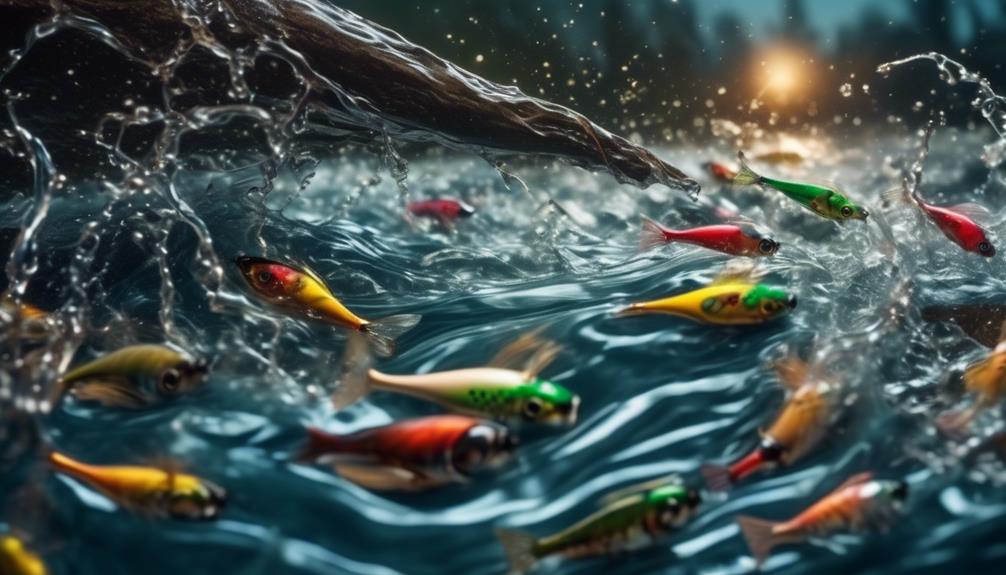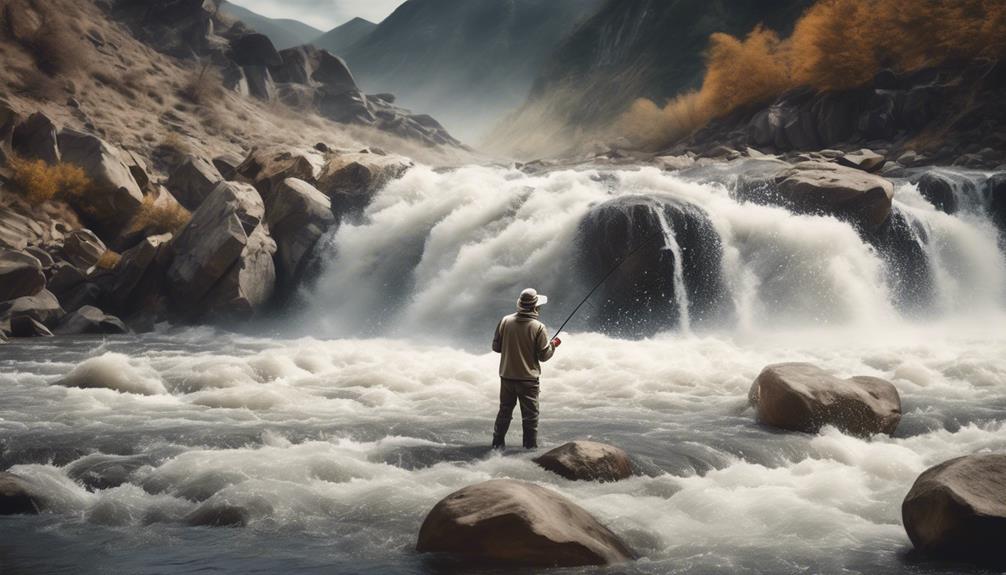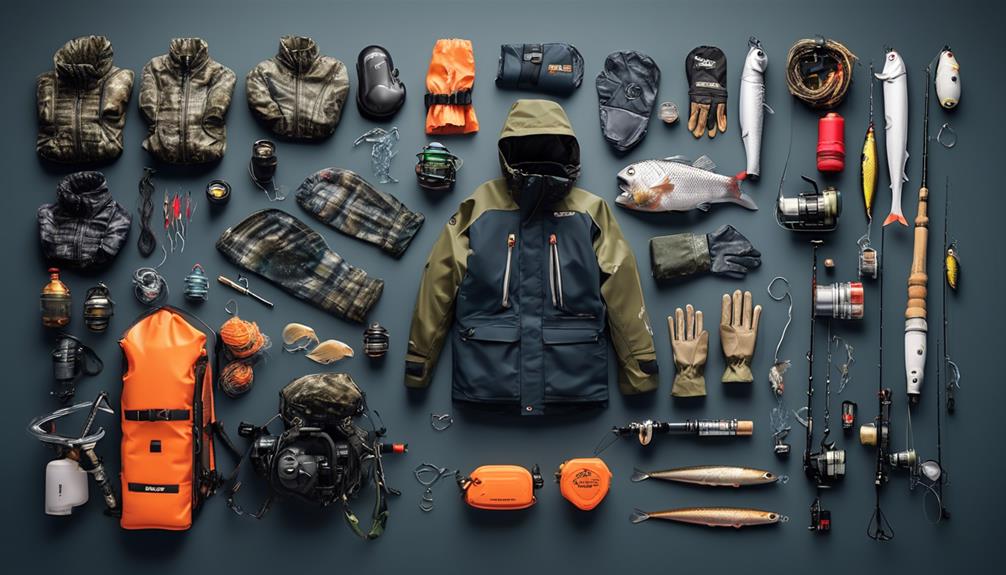Are you tired of casting your line into a river, only to come up empty-handed? Have you ever wondered if using specific tackle for river angling could make a difference in your catch?
There's a reason why experienced anglers carefully select their gear based on the type of water they're fishing in. It's not just a matter of preference; it's about giving yourself the best chance of success.
So, what makes river-specific tackle so crucial? Keep reading to discover the key factors that can significantly impact your angling results.
Importance of River-Specific Tackle
When angling in rivers, using tackle specifically designed for the unique conditions of river fishing can significantly improve your success and enjoyment. River currents present a distinct challenge when compared to still waters, and having the right tackle can make all the difference.
River-specific tackle is designed to withstand the force of river currents, allowing you to present your bait naturally and keep it in the strike zone longer. This is crucial for enticing river-dwelling fish, as they often position themselves strategically in relation to the current flow.
In addition to dealing with the powerful currents, river-specific tackle is also tailored for durability and resilience, essential for withstanding the rigors of river angling. The constant flow of water, rocky bottoms, and potential snags demand tackle that can endure these harsh conditions. Proper tackle maintenance is equally important; regularly inspecting and maintaining your gear will ensure it remains in optimal condition, reducing the risk of equipment failure at crucial moments.
River-specific tackle often includes features such as heavier weights, stronger lines, and specific bait presentations that excel in river environments. By investing in tackle designed specifically for river angling, you'll be better equipped to handle the challenges posed by river currents and increase your chances of landing that prized catch.
Factors Influencing Tackle Selection
To select the appropriate tackle for river angling, consider the specific characteristics of the river and the behavior of the target fish species. Factors such as water flow, depth, clarity, and the presence of obstacles like rocks or logs all influence the type of tackle you should use.
For example, in a river with swift currents, you may need heavier sinkers to keep your bait in place, while in shallower waters, lighter sinkers may be more appropriate. Additionally, the size and behavior of the fish in the river will determine the strength of the fishing line and the size of hooks needed.
The weather and time of year also play a crucial role in tackle selection. During different seasons, fish may exhibit varying feeding patterns and preferences for bait, impacting the type of lures or baits you should use. Moreover, weather conditions such as wind and rain can affect the visibility of your line and the movement of the water, influencing the type of tackle that would be most effective.
Furthermore, understanding the specific species of fish present in the river is essential. Different fish have different feeding habits and preferences, and knowing these details can help you select the most suitable tackle. For example, if you're targeting bass in a river with heavy vegetation, weedless lures may be the best choice to prevent snagging.
When selecting tackle for river angling, taking into account these factors and the specific conditions of the river will greatly enhance your chances of a successful and enjoyable fishing experience.
Essential Tackle for River Angling
Selecting the right tackle for river angling is vital to ensure you're well-prepared for the specific conditions and fish species you'll encounter.
When it comes to essential tackle for river angling, understanding riverbank techniques and bait selection is crucial. For riverbank techniques, a sturdy landing net is essential for safely securing your catch, especially when dealing with larger fish species commonly found in rivers. Additionally, having a pair of polarized sunglasses can greatly aid in spotting fish and navigating the constantly changing river environment.
Bait selection is equally important, and having a variety of artificial lures and natural baits such as worms, minnows, or insects can significantly increase your chances of a successful catch. These baits can be used to target different fish species and adapt to their varying feeding habits and preferences.
In river angling, casting accuracy is paramount due to the often narrow and winding nature of river channels. As such, having a quality spinning or baitcasting rod and reel combo can greatly improve your casting accuracy and control, allowing you to effectively target specific areas where fish are likely to be hiding.
Understanding fish behavior is another crucial aspect of river angling, and having a reliable fish finder can help you locate schools of fish and understand their movements within the river.
Benefits of Specialized River Gear
Understanding the importance of specialized river gear is essential for optimizing your angling experience and increasing your chances of a successful catch. When it comes to river angling, having the right equipment tailored for the specific conditions can make a significant difference in your fishing endeavors.
Here are some benefits of using specialized river gear:
- Custom Rod: Using a custom rod designed for river fishing allows you to have better control and accuracy when casting in narrow or fast-flowing waters. These rods are often crafted with specific actions and lengths to accommodate the unique challenges of river angling, giving you a distinct advantage over generic fishing rods.
- Water Clarity: Specialized river gear takes into account the varying water clarity commonly found in rivers. Different lures, lines, and hooks are designed to perform optimally in clear or murky waters, maximizing your visibility and increasing the likelihood of enticing bites from fish.
- Enhanced Sensitivity: River-specific gear is built with enhanced sensitivity to detect even the subtlest of bites in dynamic river environments. This heightened sensitivity can make a significant difference in feeling and responding to the movements of fish amidst the varying currents and obstructions present in riverbeds.
Investing in specialized river gear tailored to the unique characteristics of river angling can greatly improve your overall fishing experience and boost your chances of landing prized catches.
Understanding River Conditions and Tackle
Navigating the complexities of river conditions and selecting the appropriate tackle requires a keen understanding of the environment and its impact on your angling strategy. One of the most crucial factors to consider when choosing tackle for river angling is the river current. The speed and strength of the current can vary significantly depending on the location, time of year, and recent weather conditions. Understanding how the current behaves in different parts of the river is essential for selecting the right tackle to effectively present your bait or lures.
Tackle selection must also take into account the depth and clarity of the water. In areas with swift currents, lighter tackle may be more suitable to prevent it from being carried away. Conversely, in deeper or murky waters, heavier tackle will help you reach the desired depth and ensure that your presentation is visible to the fish.
Additionally, the structure of the riverbed, such as rocks, logs, or vegetation, can impact your choice of tackle. For example, using a heavy sinker in areas with obstacles could result in frequent snags, while lighter tackle may allow for a more controlled presentation.
Selecting the Right Line for Rivers
When fishing in rivers, it's crucial to choose the right line that matches the current and water conditions for optimal angling success. Selecting the appropriate line strength is essential for river angling. Consider the water currents and the size of the fish you're targeting when choosing the line strength. A heavier line may be required in areas with strong currents or when targeting larger fish, while lighter lines may be suitable for calmer waters or smaller fish.
Additionally, the visibility of the line is important. In clear river waters, a more transparent line is less likely to spook the fish, while in murky waters, a higher visibility line can help you keep track of your line and detect bites more easily.
Knot tying is another crucial aspect when selecting the right line for river angling. Ensure that you're proficient in tying strong and reliable knots, as river currents can put a lot of strain on your line and knots. Practice tying knots such as the Palomar knot, Improved Clinch knot, and the Uni knot to ensure your line is securely connected to your hooks or lures.
Matching Lures to River Environments

Selecting the right line strength for river angling is crucial for optimal success, and now you'll learn about matching lures to specific river environments to further enhance your angling experience.
When it comes to river lure selection, it's essential to consider the dynamics of the fishing environment. Different river environments, such as fast-flowing streams, deep pools, or rocky riverbeds, require specific types of lures to effectively attract fish.
In fast-flowing rivers, where the current is strong, opt for lures that can dive deep and remain stable in the water, such as crankbaits or spinners. These lures are designed to resist the force of the current, allowing you to reach the desired depth and maintain control over your presentation.
In contrast, in slower-moving or still waters, soft plastic lures like worms or swimbaits can be more effective, as they mimic natural movement and are more visible to fish in these calmer conditions.
Additionally, when fishing in rocky riverbeds, choosing lures with weed guards or those that can bounce off obstacles without getting stuck can save you time and frustration.
Understanding the specific dynamics of the river environment you're fishing in will help you select the right lures to maximize your chances of a successful angling experience. By adapting your lure selection to the unique characteristics of each river environment, you can significantly improve your overall fishing performance.
Adapting Terminal Tackle for River Fishing
Adapting your terminal tackle for river fishing is essential for optimizing your angling success in varying river environments. When fishing in rivers, the current plays a significant role in determining the type of terminal tackle you should use. Here are some key factors to consider when customizing your tackle for river fishing:
- Weighted Hooks: In areas with strong river currents, using weighted hooks can help your bait reach the desired depth and stay there despite the swift flow. This ensures that your bait remains in the strike zone for a longer period, increasing your chances of a successful catch.
- Adjustable Floats: Utilizing adjustable floats allows you to control the depth at which your bait or lure is presented in the water. This is particularly useful when fishing in varying current speeds, as you can easily adapt to different flow conditions without having to constantly re-rig your setup.
- Sinker Selection: Depending on the speed of the river current, it's crucial to have a range of sinker weights at your disposal. Lighter sinkers are suitable for slower currents, while heavier ones are necessary to anchor your bait in faster flows, preventing it from being swept away.
Frequently Asked Questions
What Are the Best Techniques for Casting Specific River Tackle?
When casting specific river tackle, it's crucial to consider rod selection for optimal casting accuracy. Understanding the river current is essential for effective lure presentation.
Ensure your rod is appropriate for the river conditions and focus on honing your casting technique to improve accuracy. Pay attention to the speed and direction of the current, and adjust your lure presentation accordingly to entice the fish in their natural habitat.
How Can I Properly Maintain and Care for My River-Specific Tackle?
To properly maintain and care for your river-specific tackle, cleaning and storage are key. Regularly clean your tackle to prevent corrosion and damage. Store it in a dry place to maintain its durability and performance.
Consider the casting techniques you use and any regulations that may impact your tackle choice. Additionally, be mindful of the environmental impact and versatility of your tackle, and take safety precautions to ensure a successful angling experience.
Are There Any Specific Regulations or Guidelines for Using Specialized River Gear in Certain River Environments?
When angling in rivers, it's essential to consider regulations and equipment compatibility. Different rivers may have specific guidelines about the type and size of tackle that can be used. It's important to check local regulations to ensure you're using gear that complies with the rules.
Additionally, using specialized river gear designed for the specific conditions of river angling can enhance your overall fishing experience and increase your chances of success.
Can River-Specific Tackle Be Used for Other Types of Fishing, Such as Lake or Ocean Fishing?
When it comes to tackle versatility, river-specific gear can often be used for other types of fishing. Many river tackle items, like lightweight rods and smaller lures, are compatible with lake or ocean fishing.
However, it's important to consider the specific environment and target species. While some river gear may work well in other settings, certain features may be better suited for the unique challenges of river angling.
Are There Any Specific Safety Measures or Precautions to Consider When Using Specialized River Tackle?
When using specialized river tackle, safety precautions are essential. Proper handling of gear and understanding the river's unique challenges is crucial.
Always wear a life jacket, especially in fast-moving water. Be mindful of the environmental impact and practice conservation efforts, such as using barbless hooks to minimize harm to fish.
Stay informed about river conditions and potential hazards. Taking these measures ensures a safe and enjoyable angling experience.
Conclusion
So, next time you head out to the river for some angling, make sure you opt for specific tackle designed for river conditions.
By understanding the importance of specialized gear, considering factors that influence tackle selection, and adapting your terminal tackle and lures to the river environment, you can greatly improve your chances of a successful and enjoyable fishing experience.
Invest in the right gear and see the difference it makes in your river angling pursuits.



